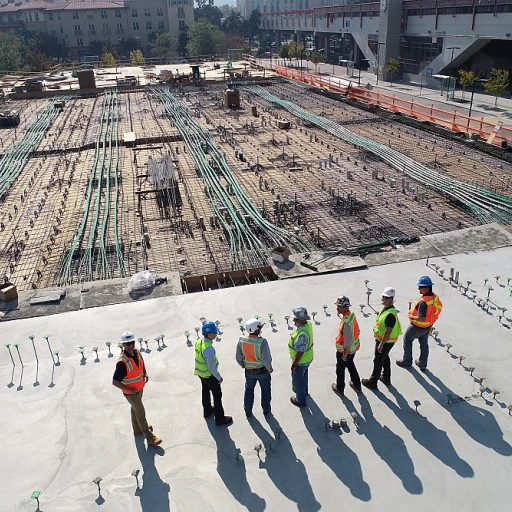
Understanding Employee Engagement
Fostering Employee Engagement for Better Teamwork
Employee engagement is more than just a buzzword. It's a genuine connection between an employee and their work that drives motivation, loyalty, and a sense of belonging. A study by Gallup highlights that engaged employees are more productive, leading to better team collaborations and improved workplace results. So, what makes an employee feel engaged? Simply put, it's about ensuring that team members know that their contributions matter. When employees perceive that they are valued, they tend to put in more effort, be more innovative, and stay committed to their team goals. Engagement strategies that focus on open communication, recognition, and opportunities for professional growth are vital.- Open Communication: Encouraging open communication within teams can enhance understanding and foster collaboration. Employees feel heard and respected, thus increasing team loyalty and overall satisfaction.
- Feedback and Recognition: Regular feedback and recognition play a crucial role in employee engagement. Knowing their achievements are appreciated gives employees a sense of accomplishment and drives them to maintain their performance levels.
- Professional Development: Providing opportunities for training and professional development helps employees grow their skillset. This directly impacts their motivation and the team dynamics as members feel better prepared to tackle tasks efficiently.
The Role of Communication in Team Collaboration
The Power of Talking: Bridging Gaps
Open communication is the lifeline of any productive team. It might sound basic, yet its impact on employee engagement and team collaboration is huge. When communication flows easily, barriers between team members break down. Everyone feels heard and valued. This doesn’t mean just emails and memos. We’re talking about honest dialogues where all voices are welcome. Talk about big impacts through small changes. Create spaces where team members feel comfortable to share their thoughts. Morning meetings, casual check-ins, or a simple "how’s it going?" can make such a difference in how employees perceive their workspace. Beyond that feel-good vibe, it’s a strategic move that can boost performance and workplace culture.Trust: The Secret Sauce
Trust turns a group of individuals into a cohesive team. It’s the foundation (yes, think of it as the bedrock) that supports every collaborative effort. When team members trust each other, they are more willing to take risks, try new things, and back each other up. Building that trust isn’t an overnight job. It’s a process—a culture—that successful companies nurture over time. Engaged employees feel secure enough to share ideas without fear of criticism. Here’s where leaders step in. They set the tone by being open, dependable, and transparent. Team building activities, shared goals, and celebrating successes can strengthen those bonds effortlessly.Make Technology Work for You
In today’s workplace, technology is more than just gadgets and gizmos. It’s a vital tool that supports collaboration and engagement. Teams need tools that help bridge communication gaps, foster collaboration, and bring a remote workforce together seamlessly. Choosing the right tool can help reduce time spent on unnecessary meetings and speed up problem-solving. Think instant messaging platforms, collaborative project management tools, and video conferencing. Don’t forget to stay informed and up to date on the latest tech trends that fuel engagement strategies. It’s about making the tech work for us—not the other way around!Building Trust Within Teams
Fostering Trust Among Team Members
Creating an environment where employees feel safe to express their ideas is at the heart of building trust. Trust starts with open communication and transparency. It's crucial for team members to feel like their opinions matter and are valued by their peers and leaders. When employees engage in honest dialogue, trust flourishes, paving the way for effective team collaboration. A personal anecdote: At a previous company I worked with, we had weekly team meetings where everyone was encouraged to share feedback and voice any concerns. Over time, this open communication became a part of our company culture, and you could actually feel the change in our workplace atmosphere. People were happier and more committed because they felt heard and respected. Building trust extends beyond just words. Actions matter too. Leaders and team members alike should consistently demonstrate reliability and integrity in their work. This might mean meeting deadlines, supporting colleagues when needed, or admitting mistakes and learning from them. Such actions strengthen the bonds within a team, ensuring everyone feels like they have each other's backs. Consistently recognized and appreciated employees feel a greater sense of belonging. This sense of connection is crucial for mental health and maintaining strong engagement levels. Recognition doesn't just boost self-esteem; it fosters a supportive environment where team members trust in their leaders' fairness and the value they bring to the company. Lastly, encourage both leaders and employees to engage in professional development. This could be through workshops, seminars, or online courses. It’s an investment in the team's skill set but also a clear message that each member’s growth is important to the organization. When employees see this commitment, trust grows because they feel valued and secure in the long term. For those interested in boosting employee engagement with effective tools, head over to our blog on better employee engagement methods. By focusing on these elements, businesses can nurture trust within teams, laying a strong foundation for collaboration and teamwork. This doesn't just happen overnight, but with consistent effort, the results will be rewarding.Leveraging Technology for Better Collaboration
Technology as a Catalyst for Teamwork
Technology is reshaping how we connect and collaborate at work. It's not just about using tools; it's about making employees feel more engaged and valued. When team members have the right tech at their fingertips, communication flows better, and collaboration becomes second nature.
Bridging Gaps with Communication Tools
Communication tools like Slack, Microsoft Teams, or Zoom are more than just platforms; they're bridges that close the gaps between team members, whether they're in the same office or scattered across the globe. These tools help create an open communication culture where everyone feels included and heard. When employees feel their voices matter, they're more likely to contribute actively, boosting team engagement.
Enhancing Collaboration with Project Management Software
Project management tools such as Trello, Asana, or Monday.com keep everyone on the same page. They make it easy to track progress, assign tasks, and set deadlines. This clarity helps employees understand their roles better and see how their work contributes to the bigger picture. When employees know their efforts are part of a larger goal, they feel more connected to the company's mission, enhancing their overall engagement.
Supporting Mental Health with Technology
Incorporating technology that supports mental health, like meditation apps or platforms offering virtual counseling, shows employees that their well-being is a priority. When employees feel supported, they're more likely to be engaged and productive. A healthy workplace culture that values mental health can significantly improve employee experience and reduce burnout.
Feedback and Recognition through Digital Platforms
Digital platforms that facilitate feedback and recognition can transform how team members feel about their contributions. Tools like Kudos or Bonusly allow for real-time recognition, making employees feel valued and appreciated. When feedback is timely and constructive, it helps employees grow and develop professionally, strengthening their commitment to the organization.
Technology, when used thoughtfully, can be a powerful ally in improving employee engagement and fostering a collaborative work environment. By integrating these tools into daily operations, companies can enhance their team-building efforts and create a more cohesive and engaged workforce.
Encouraging Feedback and Recognition
Encouraging feedback and acknowledging the hard work of your team members can turbocharge employee engagement. But let's face it, not all feedback and recognition efforts hit the mark. How does one strike the right balance so everyone in the team feels valued and motivated to keep giving their best? It's more than just ticking it off the list—it’s the manner in which it's delivered, the sincerity behind it, and its consistency over time that truly counts.
The Power of Encouraging Feedback
Feedback, when done right, can be a goldmine for professional development. It's not about sugar-coating or doling out compliments left and right; it's about being constructive, honest, and helpful. Leaders and employees both have roles to play here. For leaders, it's crucial to establish a culture of open communication where giving and receiving feedback feels natural. When feedback is an ongoing conversation, it turns into a tool for growth rather than just criticism.
An effective engagement strategy includes regular check-ins and engagement surveys to gauge how employees feel about their roles, the workplace, and the company culture. A simple, "How's it going with the new project?" can open doors to bigger discussions that promote better collaboration.
Recognition: More Than Just a Pat on the Back
Recognition is the other side of the coin. While a pat on the back might not seem like much, it can be tremendously motivating if genuine. Recognizing hard work can take many forms—verbal praise in meetings, spotlighting achievements in company emails or newsletters, or even awarding small incentives. The goal is to make employees feel appreciated and acknowledged for their contributions.
When team members see their efforts being recognized, it fuels their desire to continue excelling and makes them feel integral to the organization's success. But it needs to be timely and specific. A generalized "Good job" doesn't cut it; instead, "Your attention to detail on the Smith project significantly improved client satisfaction" shows specific appreciation that goes a long way.
Building a Feedback and Recognition Culture
Creating an environment where feedback and recognition regularly occur requires consistent effort and involvement from everyone in the organization. It’s not solely the responsibility of leaders—team members can recognize each other’s efforts too. Tools like employee experience platforms can also help structure this process, ensuring feedback loops are maintained, and team engagement remains dynamic and refreshing.
Stay proactive about celebrating milestones and achievements, whether they are individual or team-based. Encouraging team building activities and initiatives can also help improve employee engagement by developing stronger bonds among team members, ultimately fostering a positive workplace culture that supports mental health and personal growth.
At the end of the day, fostering an environment that promotes open feedback and consistent recognition keeps employees engaged and contributes to a happier, more productive workforce. Keep the lines of communication open, celebrate the wins, and watch your team flourish within your business.
For extensive insights on strategies to improve employee engagement, explore technology and collaboration tools that can support employee engagement initiatives in your company.






